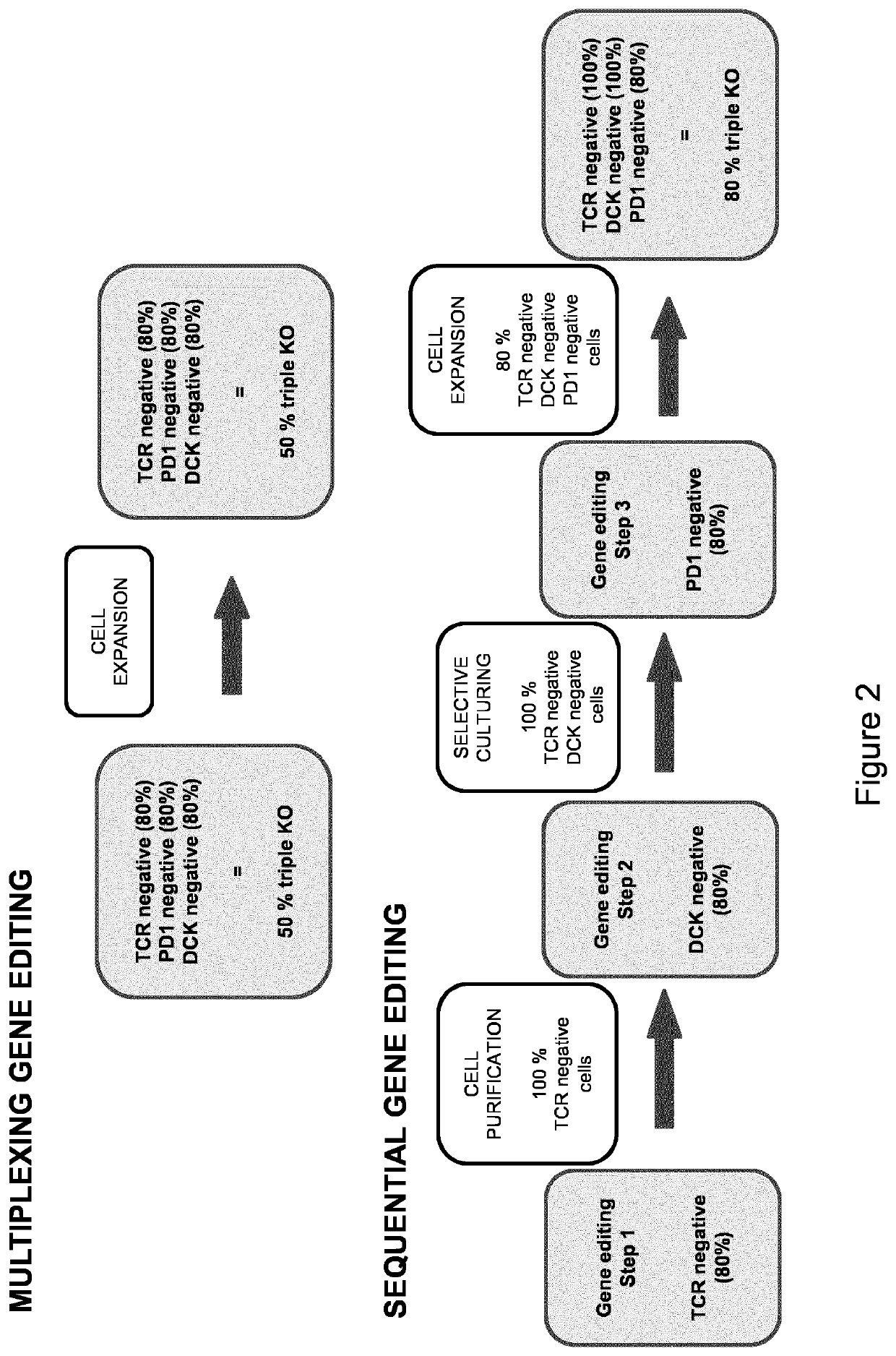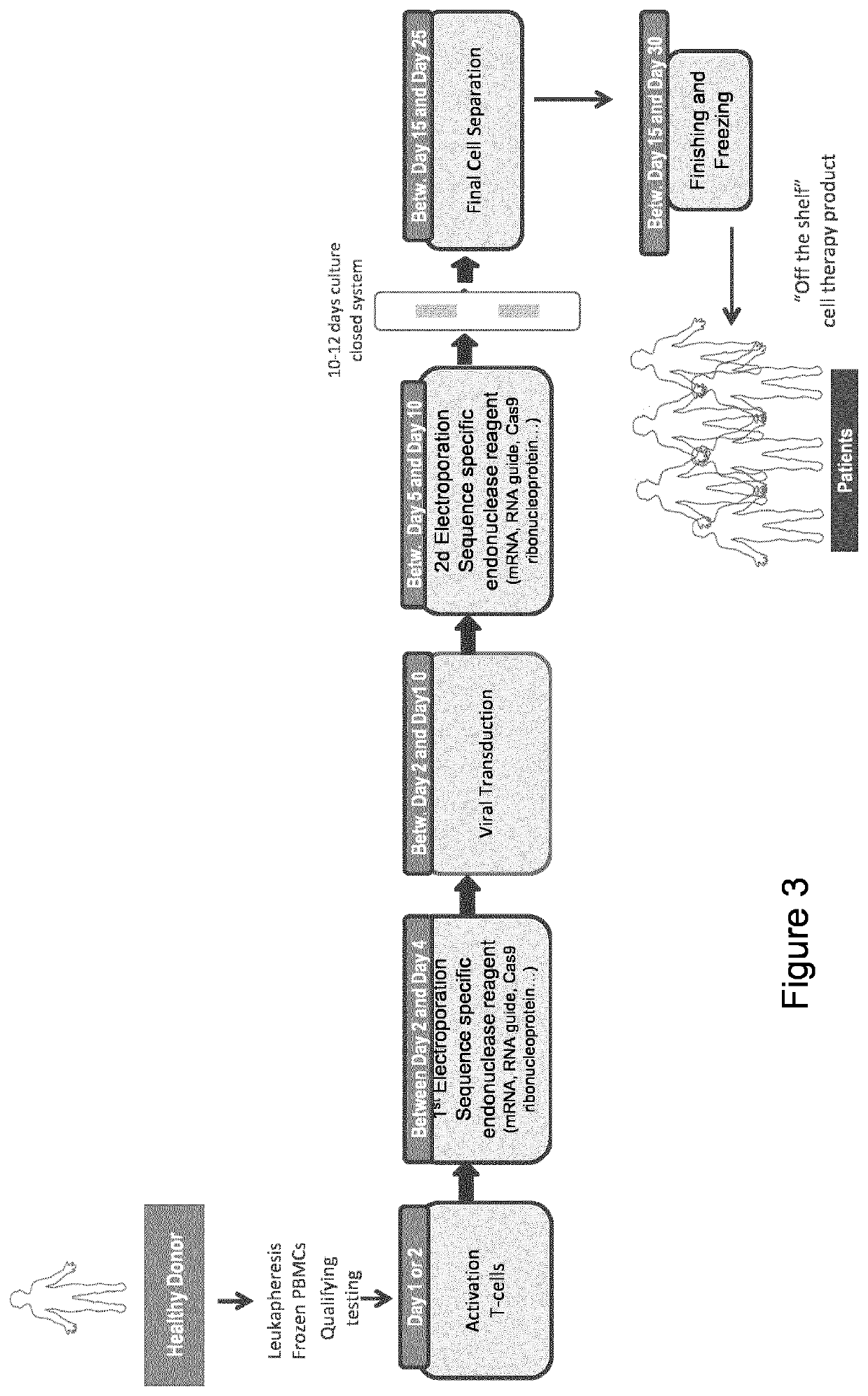Sequential gene editing in primary immune cells
- Summary
- Abstract
- Description
- Claims
- Application Information
AI Technical Summary
Benefits of technology
Problems solved by technology
Method used
Image
Examples
example 1
ous vs. Sequential Electroporation of TRAC and CD52 TALE-Nucleases into T Cells
[0346]In order to analyze the impact of sequential electroporation of TALE-nuclease reagents on the overall survival of T-cells and gene knock-out efficiency, we have submitted activated primary human T cells from a single donor sample to electroporation by using TALEN® reagents (Cellectis, Paris, France) specific for TRAC gene (TCR alpha chain) according to the following experimental procedure. The amino acid sequences of the various TALEN® heterodimers used in this experiment are given in Table 3):
[0347]Briefly, frozen human PBMCs (AlICells) were thawed and activated using anti CD3 and anti CD28 antibodies-coated beads (Dynabeads, Life Technologies, Carlsbad, Calif., United States) for 3 days. After magnetic beads removal (Day 4), 5×106 activated T cells were transfected with 10 μg of both mRNA encoding TALEN either simultaneously or sequentially with a 6 hour, 20 hour or 40 hour intervals by using Agil...
example 2
ous or Sequential Electroporation of mRNA Encoding TRAC and PD1 TALE-Nucleases Into T Cells
[0354]Simultaneous electroporation of two TALE-Nuclease heterodimers was found to be highly efficient for performing simultaneous gene knock-out in Poirot et al. (Multiplex Genome-Edited T-cell Manufacturing Platform for “Off-the-Shelf” Adoptive T-cell Immunotherapies (2015) Cancer Res. 75: 3853-64). However, unwanted events such as off-site cleavage or translocation were found to occur in certain instances. For instance, co-transfection of mRNA encoding TRAC TALEN® and PD1 TALEN® leads to the occurring of off-site cleavage activity due to the pairing of the TRAC TALEN left arm and PD1 TALEN left arm. Frequency of off-site cleavage (as well as on-site cleavage) is defined by the frequency of mutated sequences (either nucleotide deletion or addition) that are generated after endonucleases cleavage and unfaithful religation of broken ends. The amino acid sequences used in this experiment encodin...
example 3
ous or Sequential Electroporation of CD38, TRAC and CD52 TALEN Into T Cells
[0359]In order to analyze the impact of sequential TALEN electroporation on overall survival of T cells and gene knock-out efficiency, we have transfected activated human T cells with TALENs specific for TRAC gene (TCR alpha chain), CD52 and CD38 (Amino acid sequences are given in Table 3) according to the following experimental procedure:
[0360]Briefly, frozen human PBMCs (AlICells) are thawed and activated using anti CD3 and anti CD28 antibodies-coated beads (TransAct, Miltenyi) for 3 days. At day 4 post thawing, 10×106 activated T cells are transfected with 10 μg of both TALEN mRNA either simultaneously or sequentially with a 24 hour (Day 5) or 48 hour (Day 6) intervals using Cellectis proprietary AgilPulse electroporator and protocols. The following conditions have been tested and compared in terms of KO efficiency and cell growth.
TABLE 2gene editing efficiency of the sequential gene editing strategies% ce...
PUM
| Property | Measurement | Unit |
|---|---|---|
| Temperature | aaaaa | aaaaa |
| Temperature | aaaaa | aaaaa |
| Length | aaaaa | aaaaa |
Abstract
Description
Claims
Application Information
 Login to view more
Login to view more - R&D Engineer
- R&D Manager
- IP Professional
- Industry Leading Data Capabilities
- Powerful AI technology
- Patent DNA Extraction
Browse by: Latest US Patents, China's latest patents, Technical Efficacy Thesaurus, Application Domain, Technology Topic.
© 2024 PatSnap. All rights reserved.Legal|Privacy policy|Modern Slavery Act Transparency Statement|Sitemap



